2018 年福建华侨大学英语翻译考研真题
Part IVocabulary and structure (30%)
Directions: There are 30 incomplete sentences in this part. For each blank there
are four choices marked A, B, C and D. Choose the one that best complete the sentence.
Then mark the corresponding letter on the answer sheet with a single line through
the center.
1.
2.
3.
Propagandaisgenerallyconsideredtobeaformof______.
A.educationB.upbringingC.indoctrinationD.instruction
In some circles, the traditional ____ attitude toward women is coming back. They
believe that women’s proper domain is in the kitchen.
A. sexual B. sexy C. sexist D. sex
Liu Xiang was awarded a gold medal in the world championships. He ____ a lot
of hard training.
A. should have experiencedB. must have experienced C. should experienceD. must
experience
4.Yesterday in our oral class, we were talking about economics. Somehow we got ____
the subject of inflation.
A. aboutB. up C. ontoD. in
5.He spent the whole day yesterday trying to get rid of the ____ in his garden.
A. grass
B. hay
C. weeds
D. wild herbs
6.Asweallknow,blueskiesarenotalwaysa_________offineweather.
A.conversionB.preservation C.guaranteeD.safety
7.Doctors are often caught in a ________ because they have to decide whether they
should tell their patients the truth or not.
A. dilemma B. puzzle C. perplexity D. bewilderment
8.Manypeoplehavethe_________thatwealthisthechiefcauseofhappiness.
A.delusion B.illusionC.fantasyD.image
9.Ifwebelievesomethingisgoodandtrueweshould_____toit.
A.holdupB.keeponC.holdonD.keepup
10.Authoritiesaremountingacampaigntocombatanalarmingriseinjuvenile_____and
drugtaking.
A.delinquencyB.mistake C.evilD.crime
�
11.TheCommitteehadmetmanytimes,buthadnotcomeupwith_____totheproblem.
A.away B.anideaC.asolutionD.amethod
12.The local peasants gave the soldiers clothes and food without which they _____
of hunger and cold.
A. would die B. will dieC. would be deadD. would have died
13.I’msureyoursuggestionwill_____theproblem.
A.contributetosolvingB.becontributedtosolve C.contributetosolve
D.becontributedtosolving
14.You and I could hardly understand, ______?
A. could I B. couldn’t youC. couldn’t we D. could we
15.Arriving at the bus stop, ______ waiting there.
A. a lot of people were B. he found a lot of people
C. a lot of people D. people were found
16.Johnis_______hardworkingthanhissister,buthefailedintheexam.
A.nolessB.nomoreC.notlessD.noso
17.Tom,myfriend’sfather,______raisedandeducatedinNewYork,livedand
lecturedinAfricamostofhislife.
A.whoB.ifC.whileD. though
18.As a first-year college student, I wish I________that time management was my
number one problem before I came to college.
A. realized B. realize C. had realized D. have realized
19.Idonotbelievethatthispreposterousschemeis_________ofourseriousconsideration.
A.worthless B.worthC.worthwhileD.worthy
20.If the whole operation _____beforehand, a great deal of time and money would have
been lost.
A. was not planned B. had not been planned C. were not planned
D. has not been planned
21.It was because the applicant was too self-confident ______he failed in the
interview.
A. that B. thereforeC. so D. to
22.________ I wanted to find out first was how long it would take to complete the
bridge.
A. That B. ThoseC. What D. Which
�
23.___ another chance, I will certainly pass the driving test.
A. Give B. Giving C. To giveD. Given
24.I’m tired _________being bossed around. He regards me as his personal servant.
A. of B. withC. by D. in
25.Neither his parents nor his teacher _____that the boy can do it well.
A. believesB. believe C.is believingD. are believing
26.I had had so many big meals by that time that the mere sight of fish and meat
turned me ______.
A. down B. offC. outD. in
27.The boys and girls sat down and began eating the delicious food________
A. enthusiastically B. whole-heartedlyC. healthily D. heartily
28.In the sentence “In the center of the square stood amonument,” the italicized
phrase is ______.
A. the subjectB. the object C. a complement D. an adverbial
29.The figure of speech in the sentence “Darrow had whispered, throwing a reassuring
arm round my shoulder” is ______
A. metaphor B. hyperboleC. transferred epithetD. metonymy
30.It had never occurred _____him that a famous secret agent would be such a fat
old man.
A. toB. for C. withD. by
Part IIReading Comprehension 40%
Directions: There are four passages in this section. Each passage is followed by
some questions or unfinished statements. For each of them there are four choices
marked A, B, C and D. You should decide on the best choice and mark the corresponding
letter on Answer Sheet.
Passage 1
Questions 31-34 are based on the following passage.
Immigrants’ adoption of English as their primary language is one measure of
assimilation into the larger United States society. Generally languages define
social groups and provide justification for social structures. Hence, a distinctive
language sets a cultural group off from the dominant language group. Throughout
United States history this pattern has resulted in one consistent, unhappy
consequence, discrimination against members of the cultural minority. Language
differences provide both a way to rationalize subordination and a ready means for
�
achieving it.
Traditionally, English has replaced the native language of immigrant groups by
the second or third generation. Some characteristics of today’s Spanish-speaking
population, however, suggest the possibility of a departure from this historical
pattern. Many families retain ties in Latin America and move back and forth between
their present and former communities. This “revolving door” phenomenon, along with
the high probability of additional immigrants from the south, means that large
Spanish-speaking communities are likely to exist in the United States for the
indefinite future.
This expectation underlies the call for national support for bilingual education
in Spanish-speaking communities’ public schools. Bilingual education can serve
different purposes, however. In the 1960s, such programs were established to
facilitate the learning of English so as to avoid disadvantaging children in their
other subjects because of their limited English. More recently, many advocates have
viewed bilingual education as a means to maintain children’s native languages and
cultures. The issue is important for people with different political agendas, from
absorption at one pole to separatism at the other.
To date, the evaluations of bilingual education’s impact on learning have been
inconclusive. The issue of bilingual education has, nevertheless, served to unite
the leadership of the nation’s Hispanic communities. Grounded in concerns about
status that are directly traceable to the United States history of discrimination
against Hispanics, the demand for maintenance of the Spanish language in the schools
is an assertion of the worth of a people and their culture. If the United States
is truly a multicultural nation—that is, if it is one culture reflecting the
contributions of many—this demand should be seen as a demand not for separation
but for inclusion.
More direct efforts to force inclusion can be misguided. For example, movements to
declare English the official language do not truly advance the cohesion of a
multicultural nation. They alienate the twenty million people who do not speak
English as their mother tongue. They are unnecessary since the public’s business
is already conducted largely in English. Further, given the present state of
understanding about the effects of bilingual education on learning, it would be
unwise to require the universal use of English. Finally, it is for parents and local
communities to choose the path they will follow, including how much of their culture
they want to maintain for their children.
31. The passage indicates that one of the characteristics of immigrant groups to
the United States has traditionally been that, after immigration, relatively few
members of the group
(A) became politically active in their new communities
(B) moved back and forth repeatedly between the United States and their former
communities
(C) suffered discrimination in their new communities at the hands of the cultural
majority
�
(D) sought assimilation into the dominant culture of the new communities they were
entering.
32. In the third paragraph, the phrase “different political agendas” refers
specifically to conflicting opinions regarding the
(A) means of legislating the assimilation of minorities into United States society
(B) extent to which Hispanics should blend into the larger United States society
(C) means of achieving non-discriminatory education for Hispanics
(D) official given responsibility for decisions regarding bilingual education
33. In the last paragraph, “It would be unwise to require the universal use of
English.” One reason for this, according to the author, is that
(A) it is not clear yet whether requiring the universal use of English would promote
or hinder the education of children whose English is limited
(B) requiring the universal use of English would reduce the cohesion of the nation’
s Hispanic communities and leadership
(C) the question of language in the schools should be answered by those who evaluate
bilingual education, not by people with specific political agendas
(D) it has been shown that bilingual education is necessary to avoid disadvantaging
in their general learning children whose English is limited
34. In the last paragraph, the author of the passage is primarily concerned with
discussing
(A) reasons against enacting a measure that would mandate the forced inclusion of
immigrant groups within the dominant United culture
(B) the virtues and limitations of declaring English the official language of the
United States
(C) the importance for immigrant groups of maintaining large segments of their culture
to pass on to their children
(D) the difference in cultures between Hispanics and other immigrant groups in the
United States
Passage 2
Questions 35-39 are based on the following passage.
As is well known and has often been described, the machine industry of recent
times took its rise by a gradual emergence out of handicraft in England in the
eighteenth century. Since then the mechanical industry has progressively been
getting the upper hand in all the civilized nations, in much the same degree in which
these nations have come to be counted as civilized. This mechanical industry now
stands dominant at the apex of the industrial system.
The state of the industrial arts, as it runs on the lines of the mechanical
industry, is a technology of physics and chemistry. That is to say, it is governed
by the same logic as the scientific laboratories. The procedure, the principles,
�
habits of thought, preconceptions, units of measurement and of valuation, are the
same in both cases.
The technology of physics and chemistry is not derived from established law and
custom, and it goes on its way with as nearly complete a disregard of the spiritual
truths of law and custom as the circumstances will permit. The realities with which
this technology is occupied are of another order of actuality, lying altogether
within the three dimensions that contain the material universe, and running
altogether on the logic of material fact. In effect it is the logic of inanimate
facts.
The mechanical industry makes use of the same range of facts handled in the same
impersonal way and directed to the same manner of objective results. In both cases
alike it is of the first importance to eliminate the “personal equation,” to let
the work go forward and let the forces at work take effect quite objectively, without
hindrance or deflection for any personal end, interest, or gain. It is the
technician’s place in industry, as it is the scientist’s place in the laboratory,
to serve as an intellectual embodiment of the forces at work, isolate the forces
engaged from all extraneous disturbances, and let them take full effect along the
lines of designed work. The technician is an active or creative factor in the case
only in the sense that he is the keeper of the logic which governs the forces at
work.
These forces that so are brought to bear in mechanical industry are of an
objective, impersonal, unconventional nature, of course. They are of the nature of
opaque fact. Pecuniary gain is not one of these impersonal facts. Any consideration
of pecuniary gain that may be injected into the technician’s working plans will
come into the case as an intrusive and alien factor, whose sole effect is to deflect,
retard, derange and curtail the work in hand. At the same time considerations of
pecuniary gain are the only agency brought into the case by the businessmen, and
the only ground on which they exercise a control of production.
35. The author of the passage is primarily discussing
(A) industrial organization in the eighteenth century
(B) the motives for pecuniary gain
(C) the technician’s place in mechanical industry
(D) the impersonal organization of industry
36. The author of the passage suggests that businessmen in the mechanical industry
are responsible mainly for
(A) keeping the logic governing the forces at work
(B) managing the profits
(C) directing the activities of the technicians
(D) employing the technological procedures of physics and chemistry
37. Which one of the following, if true, would contradict the author’s belief that
the role of technician is to be “the keeper of the logic” in the fourth paragraph?
(A) All technicians are human beings with feelings and emotions.
�
(B) An interest in pecuniary gain is the technician’s sole motive for participation
in industry.
(C) The technician’s working plans do not coincide with the technician’s pecuniary
interests.
(D) Technicians are employed by businessmen to oversee the forces at work.
38. From the author’s perspective, which one of the following statements about the
evolution of the industrial system is TRUE?
(A) The handicraft system of industry emerged in eighteenth-century England and was
subsequently replaced by the machine industry.
(B) The handicraft system of industrial production has gradually given rise to a
mechanistic technology that dominates contemporary industry.
(C) The mechanical system of production that preceded the handicraft system was the
precursor of contemporary means of production.
(D) The industrial arts developed as a result of the growth of the mechanical industry
that followed the decline of the handicraft system of production.
39. Which one of the following best describes the author’s attitude toward scientific
techniques?
(A) hostile
(B) idealistic
(C) ironic
(D) neutral
Passage 3
Questions 40-45 are based on the following passage.
Historians sometimes forget that history is continually being made and
experienced before it is studied, interpreted, and read. These latter activities
have their own history, of course, which may impinge in unexpected ways on public
events. It is difficult to predict when “new pasts” will overturn established
historical interpretations and change the course of history.
In the fall of 1954, for example, C. Vann Woodward delivered a lecture series
at the University of Virginia which challenged the prevailing dogma concerning the
history, continuity, and uniformity of racial segregation in the South. He argued
that the Jim Crow laws of the late nineteenth and early twentieth centuries not only
codified traditional practice but also were a determined effort to erase the
considerable progress made by Black people during and after Reconstruction in the
1870’s. This revisionist view of Jim Crow legislation grew in part from the research
that Woodward had done for the NAACP legal campaign during its preparation for Brown
v. Board of Education. The Supreme Court had issued its ruling in this epochal
desegregation case a few months before Woodward’s lectures.
The lectures were soon published as a book, The Strange Career of Jim Crow. Ten
years later, in a preface to the second revised edition, Woodward confessed with
ironic modesty that the first edition “had begun to suffer under some of the
�
handicaps that might be expected in a history of the American Revolution published
in 1776.” That was a bit like hearing Thomas Paine apologize for the timing of his
pamphlet Common Sense, which had a comparable impact. Although Common Sense also
had a mass readership, Paine had intended to reach and inspire: he was not a historian,
and thus not concerned with accuracy or the dangers of historical anachronism. Yet,
like Paine, Woodward had an unerring sense of the revolutionary moment, and of how
historical evidence could undermine the mythological tradition that was crushing
the dreams of new social possibilities. Martin Luther King, Jr., testified to the
profound effect of The Strange Career of Jim Crow on the civil rights movement by
praising the book and quoting it frequently.
40. The “new pasts” mentioned in the first paragraph can best be described as the
(A) occurrence of events extremely similar to past events
(B) history of the activities of studying, interpreting, and reading new historical
writing
(C) change in people’s understanding of the past due to more recent historical
writing
(D) overturning of established historical interpretations by politically motivated
politicians
41. It can be inferred from the second paragraph that the “prevailing dogma” held
that
(A) Jim Crow laws were passed to give legal status to well-established discriminator
practices in the South
(B) Jim Crow laws were passed to establish order and uniformity in the discriminatory
practices of different southern states
(C) the continuity of racial segregation in the South was disrupted by passage of
Jim Crow laws
(D) the Jim Crow laws of the late nineteenth and early twentieth centuries were
passed to reverse the effect of earlier Jim Crow laws
42. Which of the following is the best example of writing that is likely to be subject
to the kinds of “handicaps” referred to in the last paragraph?
(A) A critique of a statewide school-desegregation plan written by an elementary
school teacher in that state
(B) A newspaper article assessing the historical importance of a United States
President written shortly after the President has taken office
(C) A scientific paper describing the benefits of a certain surgical technique
written by the surgeon who developed the technique
(D) Diary entries narrating the events of a battle written by a soldier who
participated in the battle
43. The passage suggests that C. Vann Woodward and Thomas Paine were similar in all
of the following ways EXCEPT:
�
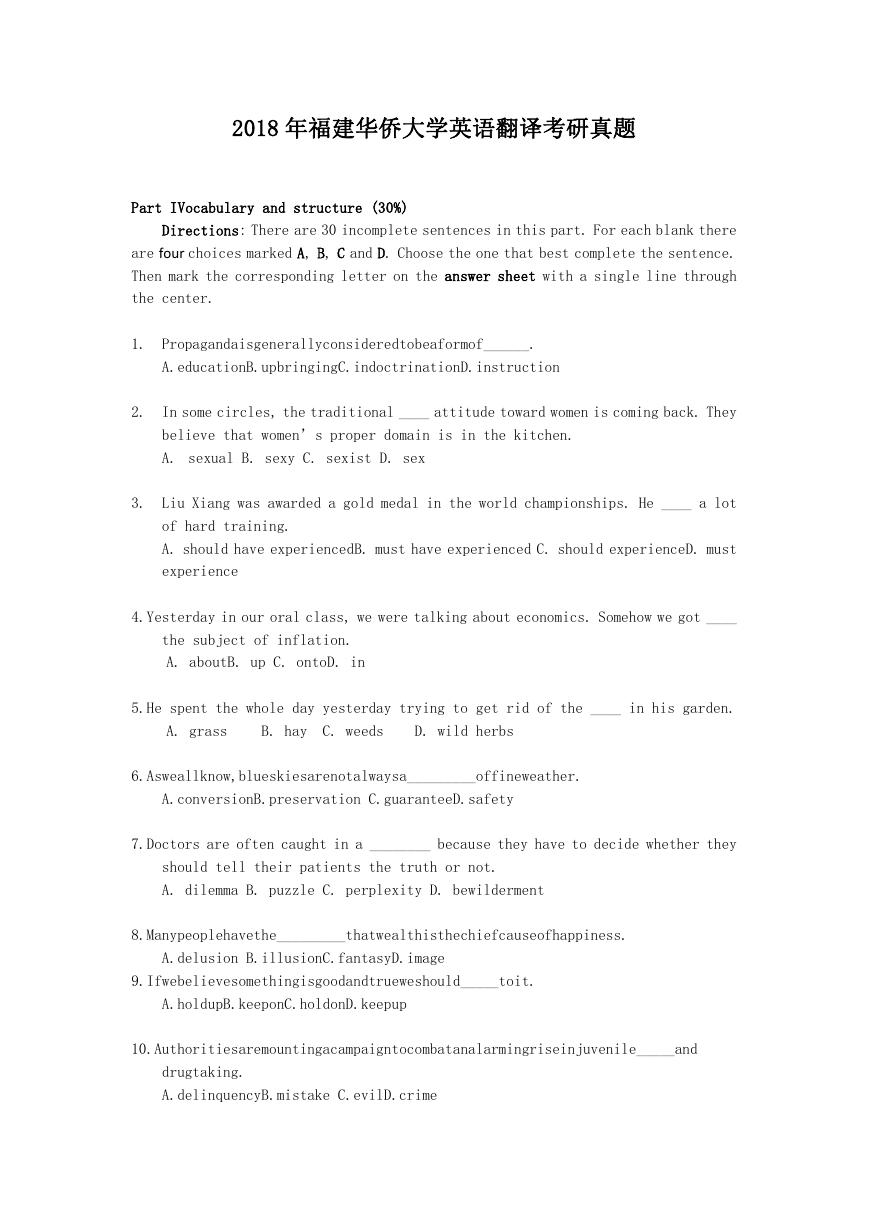
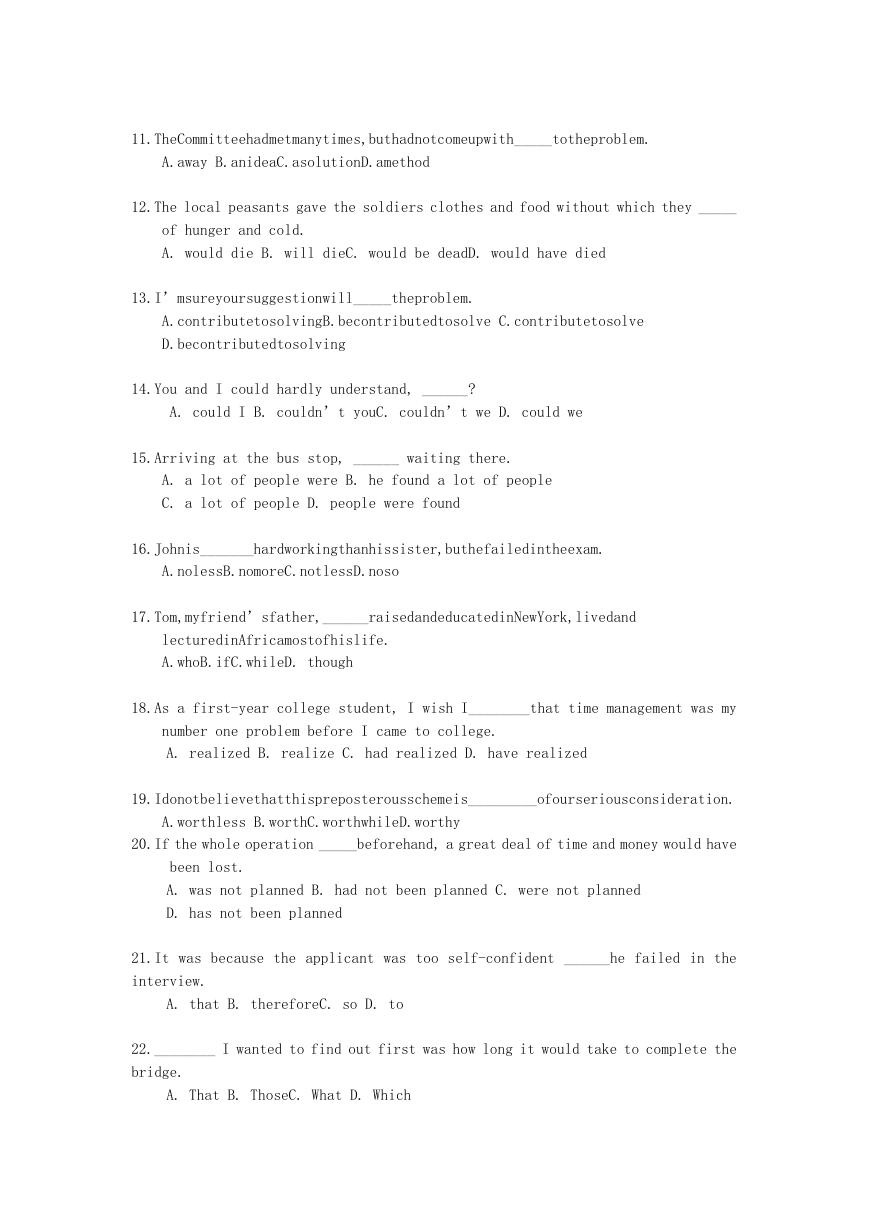
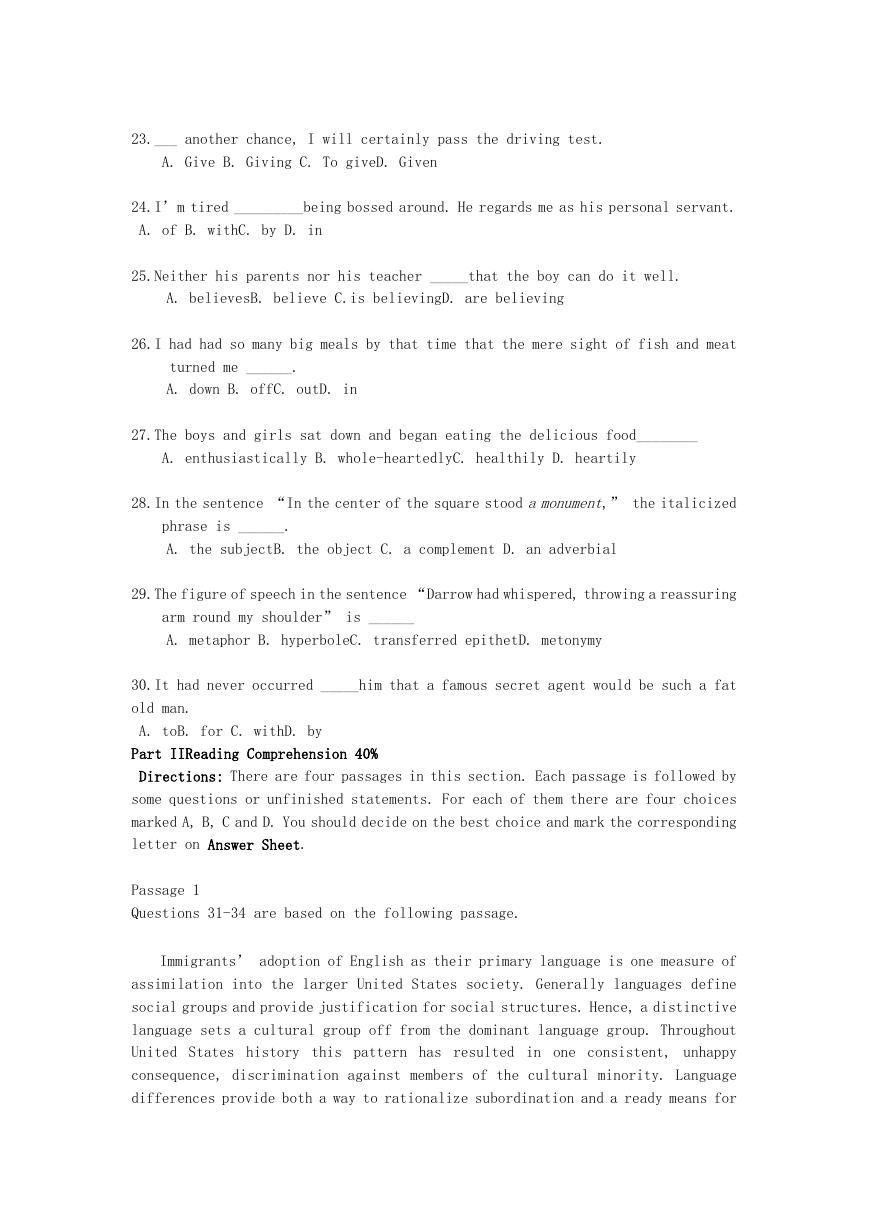
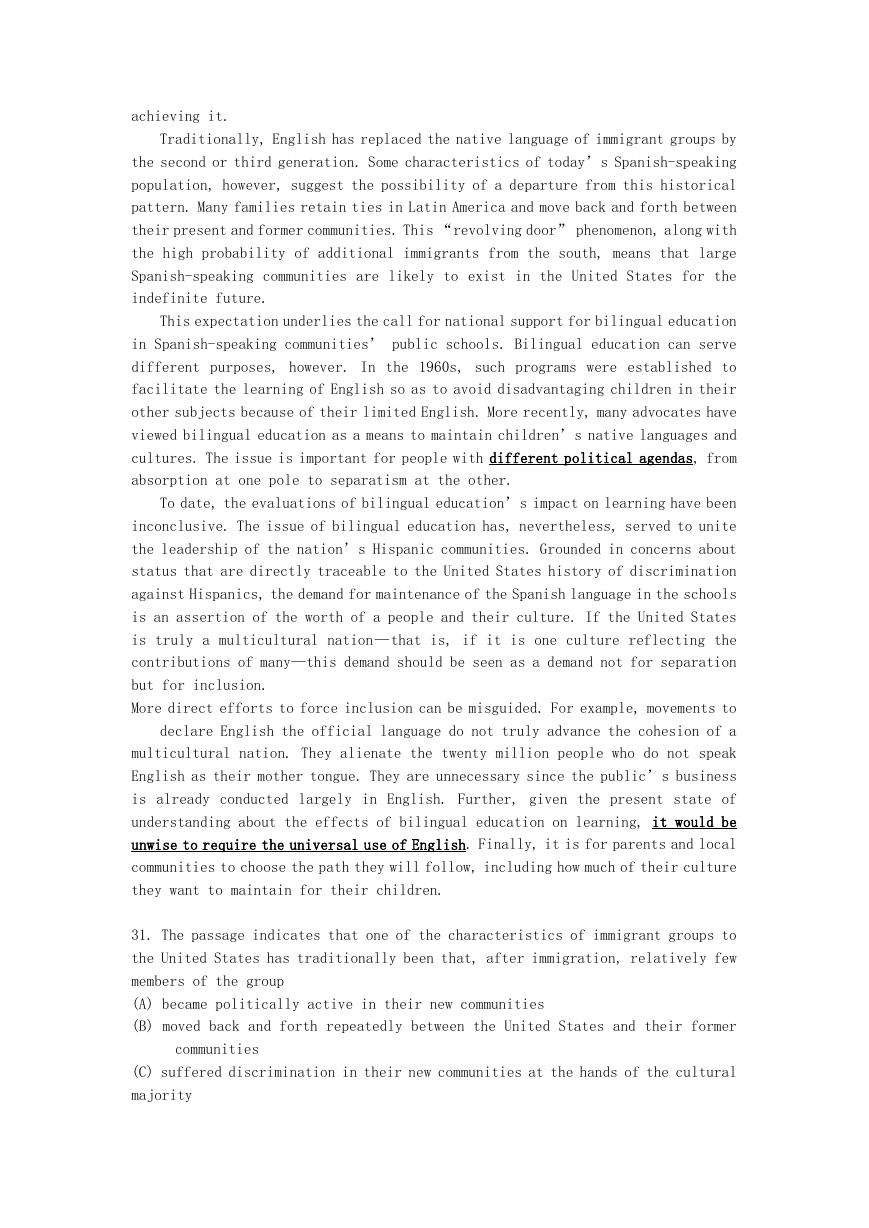
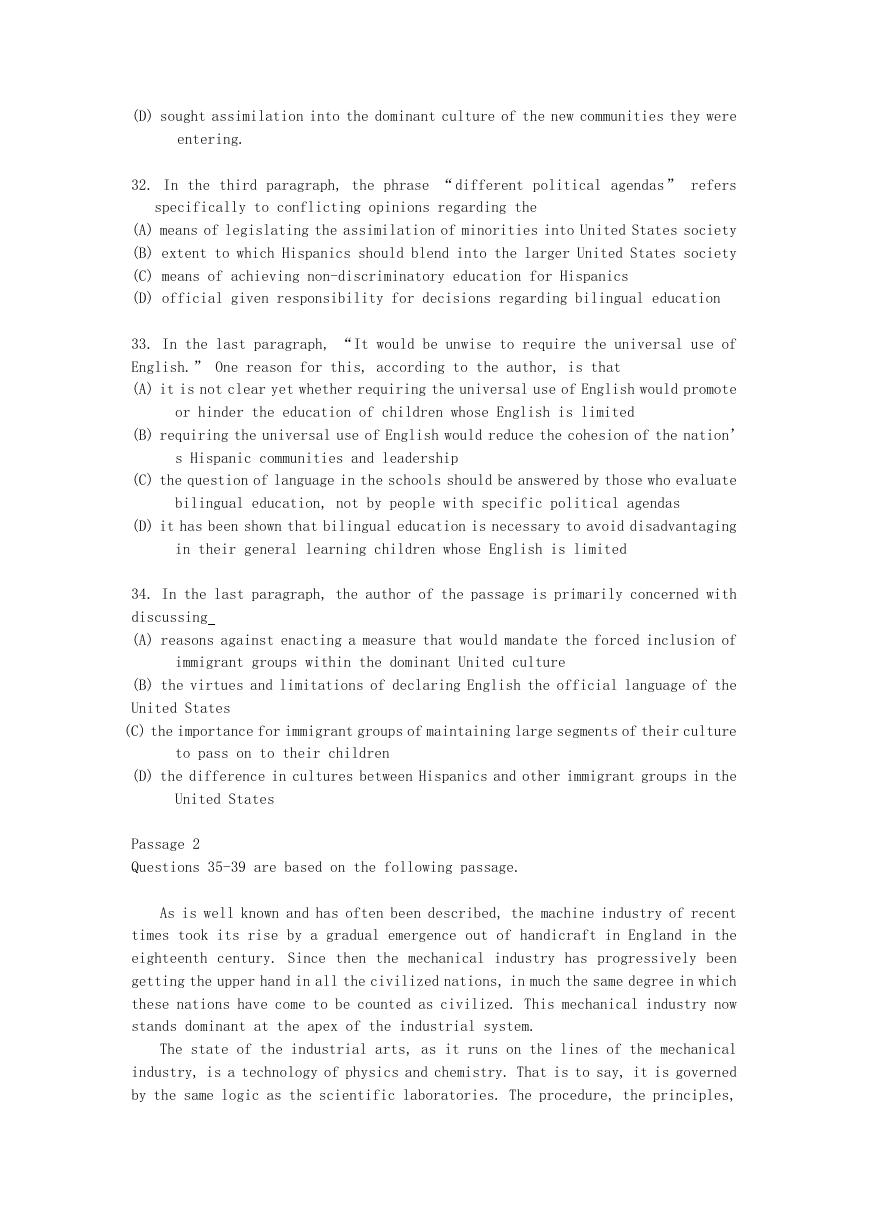
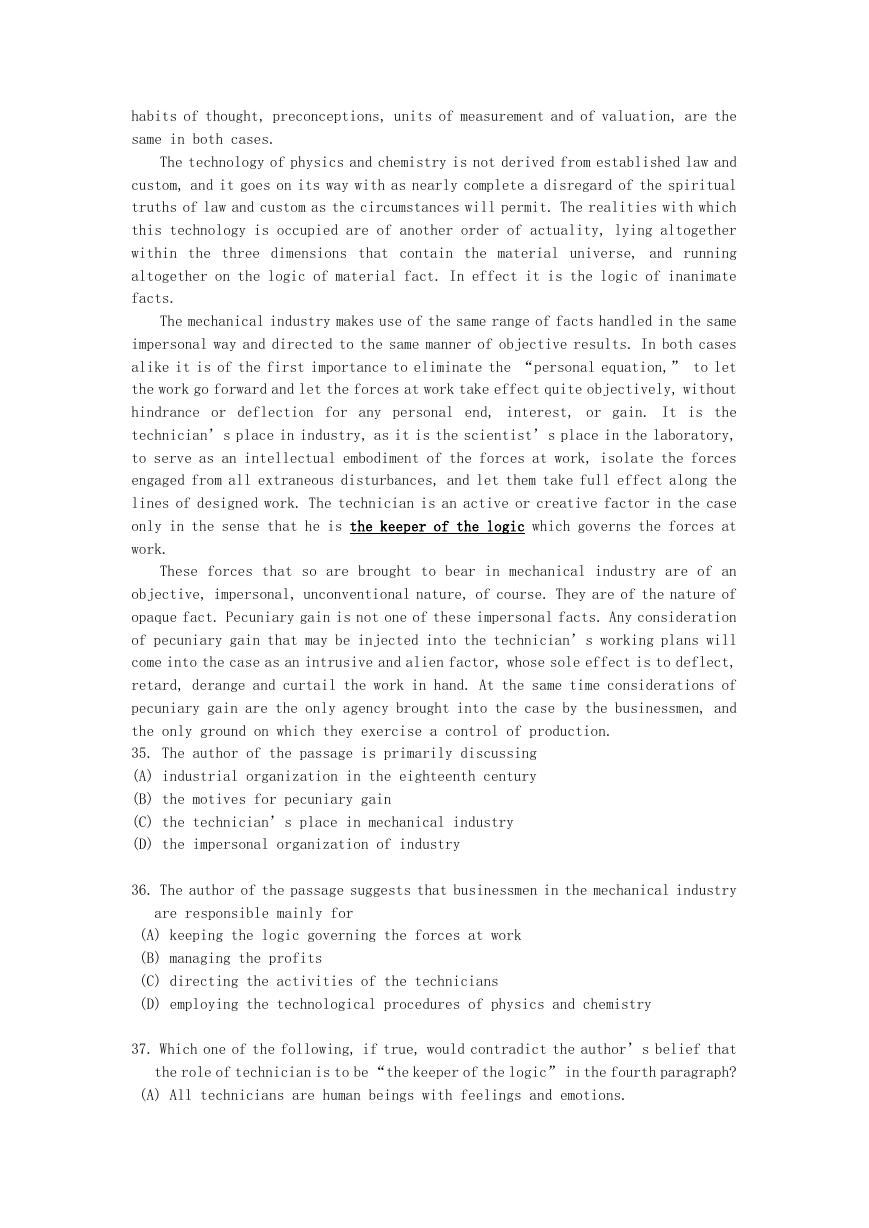

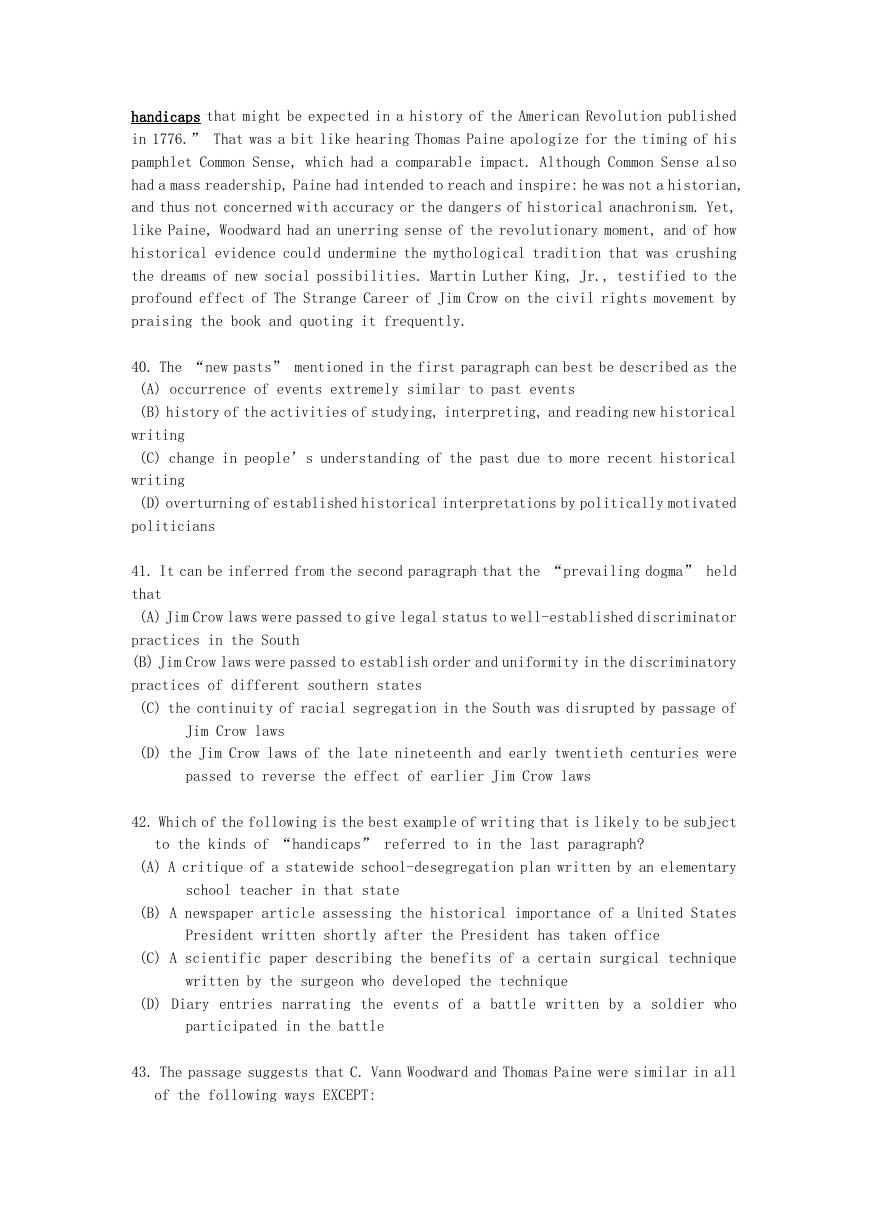








 2023年江西萍乡中考道德与法治真题及答案.doc
2023年江西萍乡中考道德与法治真题及答案.doc 2012年重庆南川中考生物真题及答案.doc
2012年重庆南川中考生物真题及答案.doc 2013年江西师范大学地理学综合及文艺理论基础考研真题.doc
2013年江西师范大学地理学综合及文艺理论基础考研真题.doc 2020年四川甘孜小升初语文真题及答案I卷.doc
2020年四川甘孜小升初语文真题及答案I卷.doc 2020年注册岩土工程师专业基础考试真题及答案.doc
2020年注册岩土工程师专业基础考试真题及答案.doc 2023-2024学年福建省厦门市九年级上学期数学月考试题及答案.doc
2023-2024学年福建省厦门市九年级上学期数学月考试题及答案.doc 2021-2022学年辽宁省沈阳市大东区九年级上学期语文期末试题及答案.doc
2021-2022学年辽宁省沈阳市大东区九年级上学期语文期末试题及答案.doc 2022-2023学年北京东城区初三第一学期物理期末试卷及答案.doc
2022-2023学年北京东城区初三第一学期物理期末试卷及答案.doc 2018上半年江西教师资格初中地理学科知识与教学能力真题及答案.doc
2018上半年江西教师资格初中地理学科知识与教学能力真题及答案.doc 2012年河北国家公务员申论考试真题及答案-省级.doc
2012年河北国家公务员申论考试真题及答案-省级.doc 2020-2021学年江苏省扬州市江都区邵樊片九年级上学期数学第一次质量检测试题及答案.doc
2020-2021学年江苏省扬州市江都区邵樊片九年级上学期数学第一次质量检测试题及答案.doc 2022下半年黑龙江教师资格证中学综合素质真题及答案.doc
2022下半年黑龙江教师资格证中学综合素质真题及答案.doc